Comprehensive Risk Management Report for Oporto Australia Restaurant
VerifiedAdded on 2023/04/04
|11
|2430
|456
Report
AI Summary
This report explores the critical importance of risk management within the hospitality industry, focusing on a case study of Oporto Australia. It identifies various types of risks, including physical, non-physical, human asset, and financial risks, and emphasizes the need for a robust risk management process to protect the company's reputation and assets. The report includes a risk ranking system and venue risk analysis tailored for Oporto, highlighting potential risks and offering recommendations for mitigation strategies. The analysis covers aspects like customer behavior, supply chain interruptions, cyber threats, and financial vulnerabilities. Key recommendations include implementing internal safety measures, managing staff performance, optimizing space for clients, securing payment processes, and ensuring timely ingredient supplies, all aimed at fostering growth and stability for Oporto restaurant.
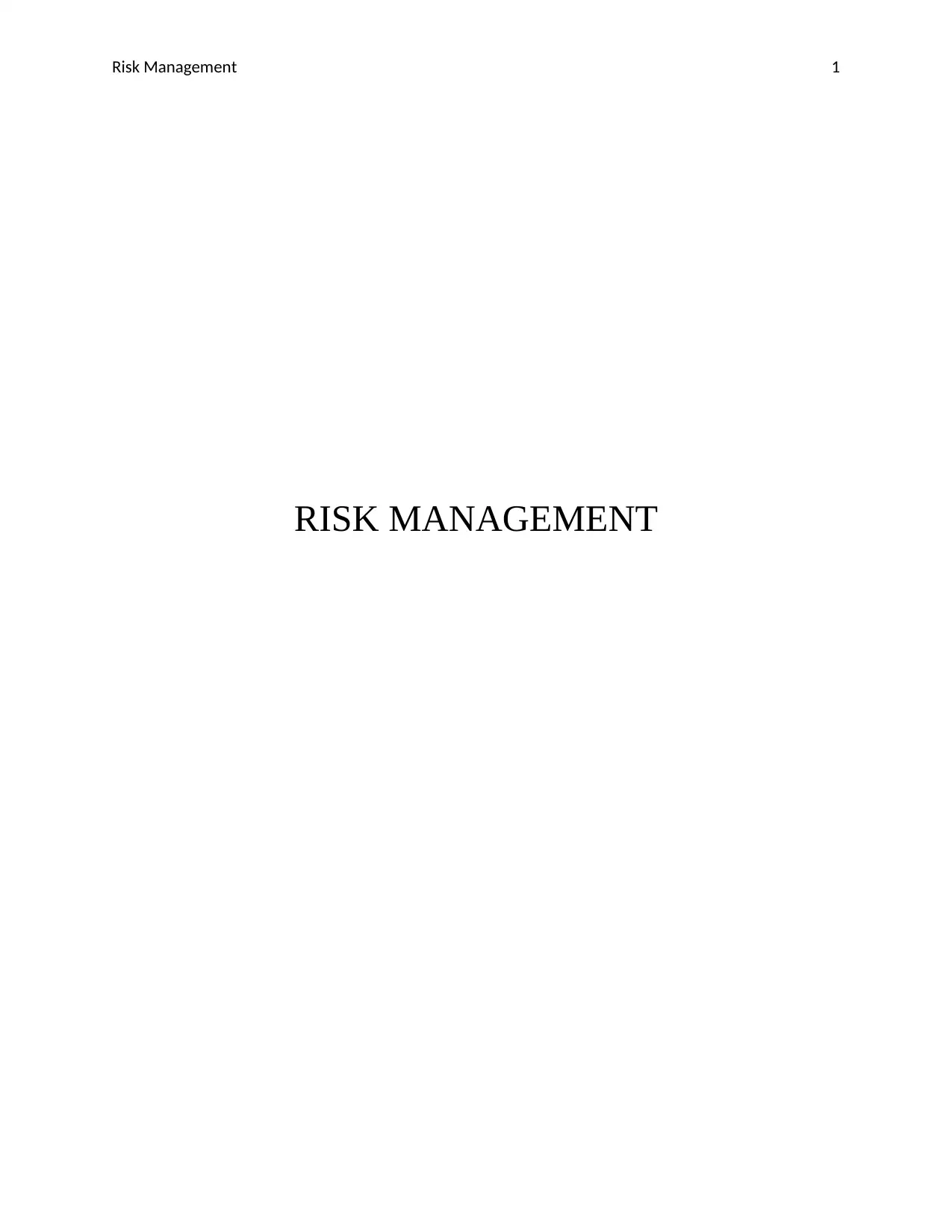
Risk Management 1
RISK MANAGEMENT
RISK MANAGEMENT
Paraphrase This Document
Need a fresh take? Get an instant paraphrase of this document with our AI Paraphraser
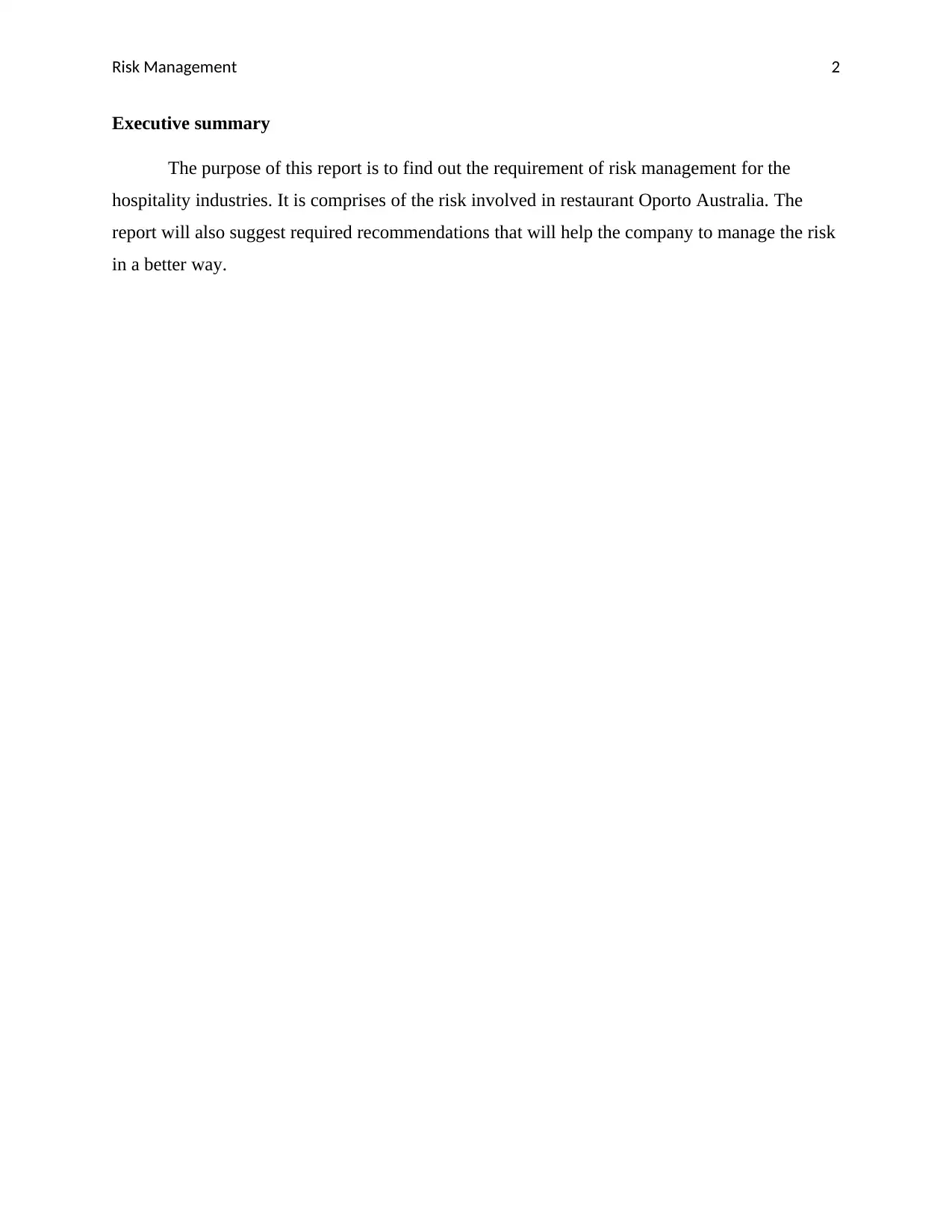
Risk Management 2
Executive summary
The purpose of this report is to find out the requirement of risk management for the
hospitality industries. It is comprises of the risk involved in restaurant Oporto Australia. The
report will also suggest required recommendations that will help the company to manage the risk
in a better way.
Executive summary
The purpose of this report is to find out the requirement of risk management for the
hospitality industries. It is comprises of the risk involved in restaurant Oporto Australia. The
report will also suggest required recommendations that will help the company to manage the risk
in a better way.
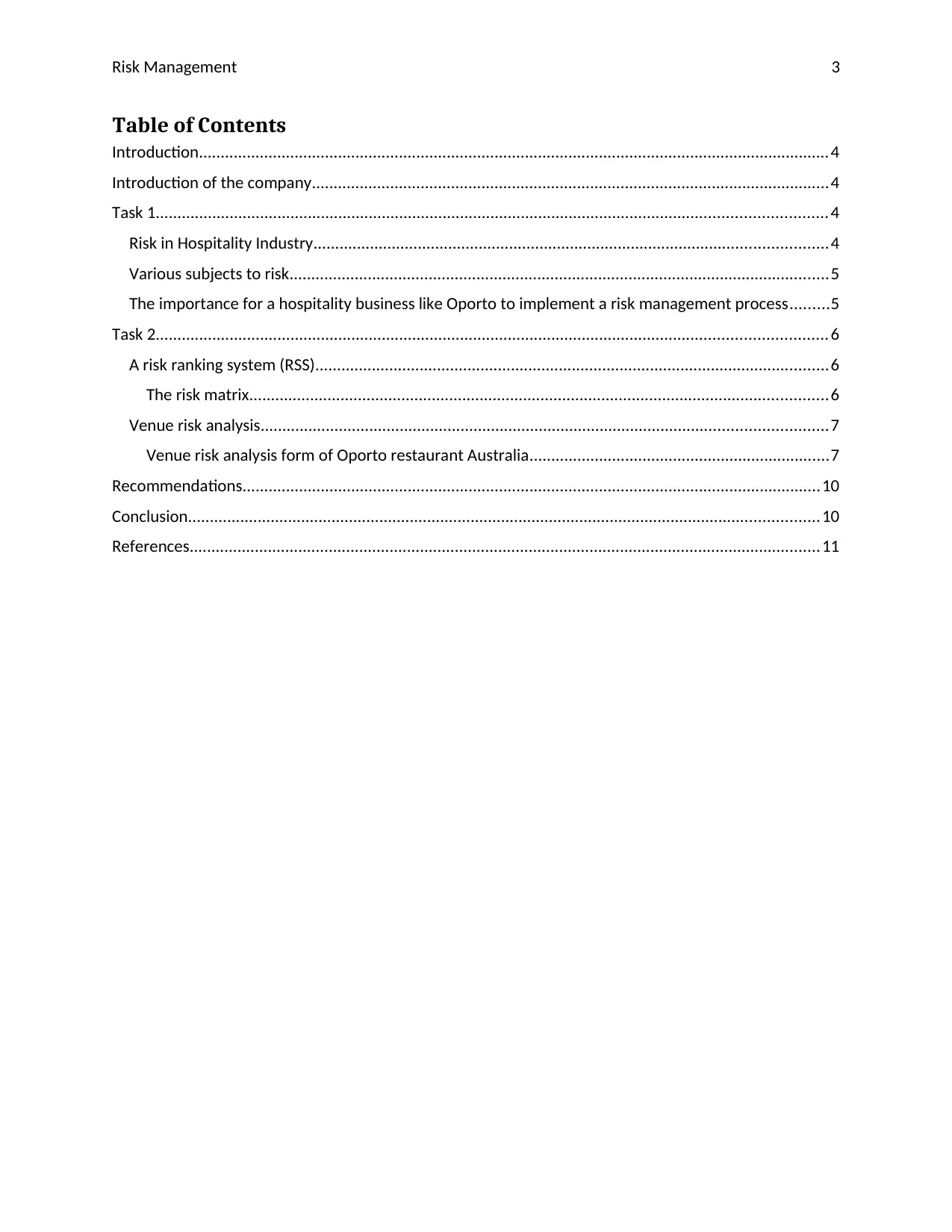
Risk Management 3
Table of Contents
Introduction.................................................................................................................................................4
Introduction of the company.......................................................................................................................4
Task 1..........................................................................................................................................................4
Risk in Hospitality Industry......................................................................................................................4
Various subjects to risk............................................................................................................................5
The importance for a hospitality business like Oporto to implement a risk management process.........5
Task 2..........................................................................................................................................................6
A risk ranking system (RSS)......................................................................................................................6
The risk matrix.....................................................................................................................................6
Venue risk analysis..................................................................................................................................7
Venue risk analysis form of Oporto restaurant Australia.....................................................................7
Recommendations.....................................................................................................................................10
Conclusion.................................................................................................................................................10
References.................................................................................................................................................11
Table of Contents
Introduction.................................................................................................................................................4
Introduction of the company.......................................................................................................................4
Task 1..........................................................................................................................................................4
Risk in Hospitality Industry......................................................................................................................4
Various subjects to risk............................................................................................................................5
The importance for a hospitality business like Oporto to implement a risk management process.........5
Task 2..........................................................................................................................................................6
A risk ranking system (RSS)......................................................................................................................6
The risk matrix.....................................................................................................................................6
Venue risk analysis..................................................................................................................................7
Venue risk analysis form of Oporto restaurant Australia.....................................................................7
Recommendations.....................................................................................................................................10
Conclusion.................................................................................................................................................10
References.................................................................................................................................................11
You're viewing a preview
Unlock full access by subscribing today!
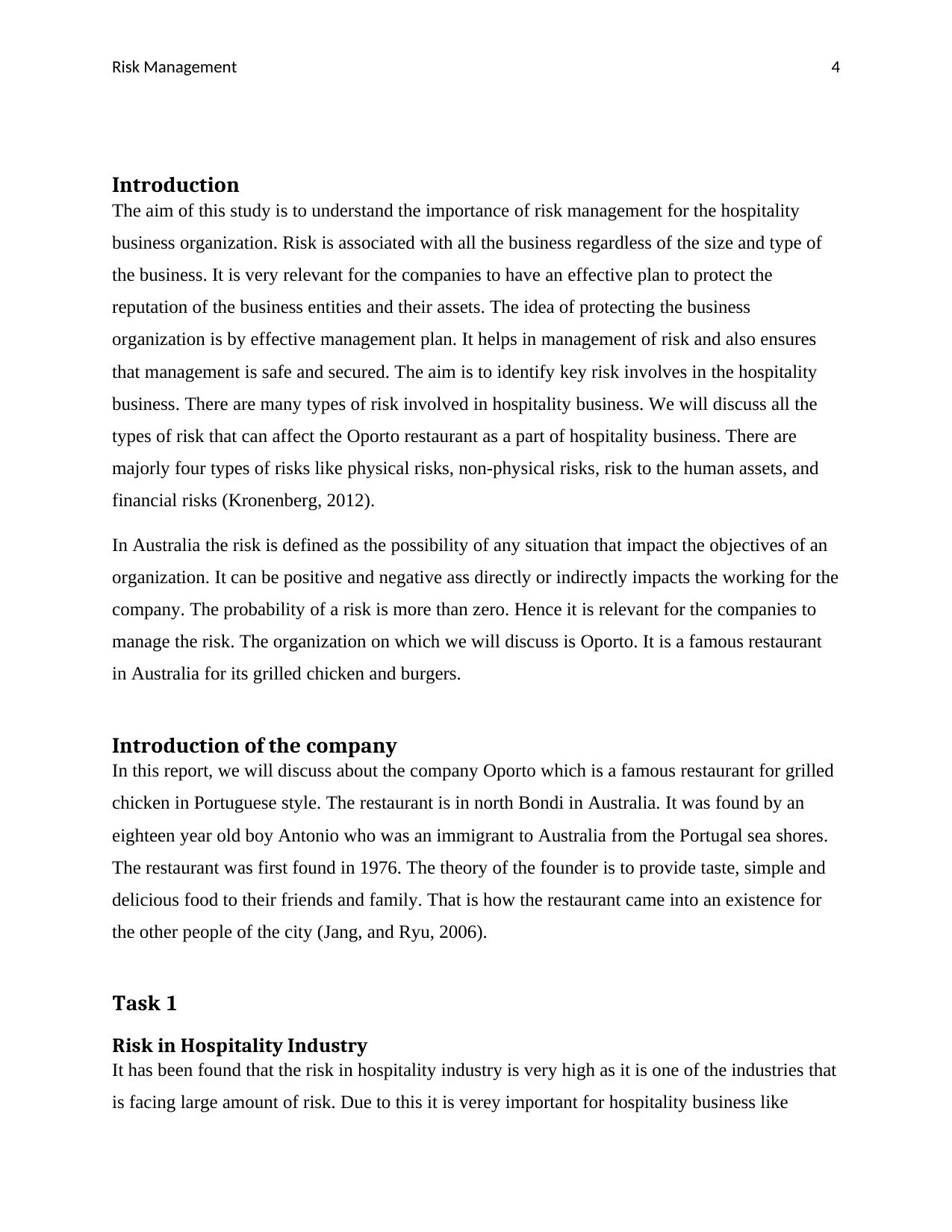
Risk Management 4
Introduction
The aim of this study is to understand the importance of risk management for the hospitality
business organization. Risk is associated with all the business regardless of the size and type of
the business. It is very relevant for the companies to have an effective plan to protect the
reputation of the business entities and their assets. The idea of protecting the business
organization is by effective management plan. It helps in management of risk and also ensures
that management is safe and secured. The aim is to identify key risk involves in the hospitality
business. There are many types of risk involved in hospitality business. We will discuss all the
types of risk that can affect the Oporto restaurant as a part of hospitality business. There are
majorly four types of risks like physical risks, non-physical risks, risk to the human assets, and
financial risks (Kronenberg, 2012).
In Australia the risk is defined as the possibility of any situation that impact the objectives of an
organization. It can be positive and negative ass directly or indirectly impacts the working for the
company. The probability of a risk is more than zero. Hence it is relevant for the companies to
manage the risk. The organization on which we will discuss is Oporto. It is a famous restaurant
in Australia for its grilled chicken and burgers.
Introduction of the company
In this report, we will discuss about the company Oporto which is a famous restaurant for grilled
chicken in Portuguese style. The restaurant is in north Bondi in Australia. It was found by an
eighteen year old boy Antonio who was an immigrant to Australia from the Portugal sea shores.
The restaurant was first found in 1976. The theory of the founder is to provide taste, simple and
delicious food to their friends and family. That is how the restaurant came into an existence for
the other people of the city (Jang, and Ryu, 2006).
Task 1
Risk in Hospitality Industry
It has been found that the risk in hospitality industry is very high as it is one of the industries that
is facing large amount of risk. Due to this it is verey important for hospitality business like
Introduction
The aim of this study is to understand the importance of risk management for the hospitality
business organization. Risk is associated with all the business regardless of the size and type of
the business. It is very relevant for the companies to have an effective plan to protect the
reputation of the business entities and their assets. The idea of protecting the business
organization is by effective management plan. It helps in management of risk and also ensures
that management is safe and secured. The aim is to identify key risk involves in the hospitality
business. There are many types of risk involved in hospitality business. We will discuss all the
types of risk that can affect the Oporto restaurant as a part of hospitality business. There are
majorly four types of risks like physical risks, non-physical risks, risk to the human assets, and
financial risks (Kronenberg, 2012).
In Australia the risk is defined as the possibility of any situation that impact the objectives of an
organization. It can be positive and negative ass directly or indirectly impacts the working for the
company. The probability of a risk is more than zero. Hence it is relevant for the companies to
manage the risk. The organization on which we will discuss is Oporto. It is a famous restaurant
in Australia for its grilled chicken and burgers.
Introduction of the company
In this report, we will discuss about the company Oporto which is a famous restaurant for grilled
chicken in Portuguese style. The restaurant is in north Bondi in Australia. It was found by an
eighteen year old boy Antonio who was an immigrant to Australia from the Portugal sea shores.
The restaurant was first found in 1976. The theory of the founder is to provide taste, simple and
delicious food to their friends and family. That is how the restaurant came into an existence for
the other people of the city (Jang, and Ryu, 2006).
Task 1
Risk in Hospitality Industry
It has been found that the risk in hospitality industry is very high as it is one of the industries that
is facing large amount of risk. Due to this it is verey important for hospitality business like
Paraphrase This Document
Need a fresh take? Get an instant paraphrase of this document with our AI Paraphraser
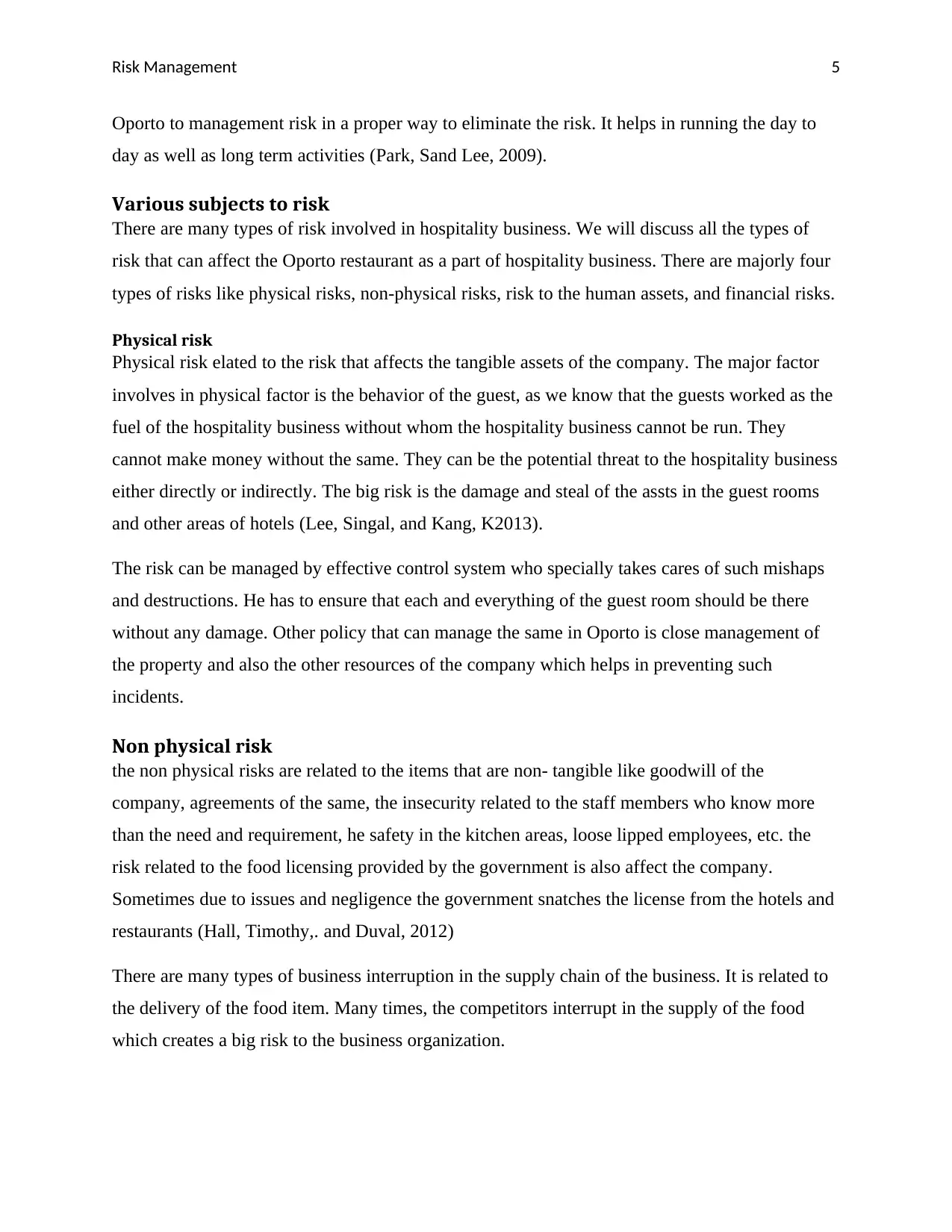
Risk Management 5
Oporto to management risk in a proper way to eliminate the risk. It helps in running the day to
day as well as long term activities (Park, Sand Lee, 2009).
Various subjects to risk
There are many types of risk involved in hospitality business. We will discuss all the types of
risk that can affect the Oporto restaurant as a part of hospitality business. There are majorly four
types of risks like physical risks, non-physical risks, risk to the human assets, and financial risks.
Physical risk
Physical risk elated to the risk that affects the tangible assets of the company. The major factor
involves in physical factor is the behavior of the guest, as we know that the guests worked as the
fuel of the hospitality business without whom the hospitality business cannot be run. They
cannot make money without the same. They can be the potential threat to the hospitality business
either directly or indirectly. The big risk is the damage and steal of the assts in the guest rooms
and other areas of hotels (Lee, Singal, and Kang, K2013).
The risk can be managed by effective control system who specially takes cares of such mishaps
and destructions. He has to ensure that each and everything of the guest room should be there
without any damage. Other policy that can manage the same in Oporto is close management of
the property and also the other resources of the company which helps in preventing such
incidents.
Non physical risk
the non physical risks are related to the items that are non- tangible like goodwill of the
company, agreements of the same, the insecurity related to the staff members who know more
than the need and requirement, he safety in the kitchen areas, loose lipped employees, etc. the
risk related to the food licensing provided by the government is also affect the company.
Sometimes due to issues and negligence the government snatches the license from the hotels and
restaurants (Hall, Timothy,. and Duval, 2012)
There are many types of business interruption in the supply chain of the business. It is related to
the delivery of the food item. Many times, the competitors interrupt in the supply of the food
which creates a big risk to the business organization.
Oporto to management risk in a proper way to eliminate the risk. It helps in running the day to
day as well as long term activities (Park, Sand Lee, 2009).
Various subjects to risk
There are many types of risk involved in hospitality business. We will discuss all the types of
risk that can affect the Oporto restaurant as a part of hospitality business. There are majorly four
types of risks like physical risks, non-physical risks, risk to the human assets, and financial risks.
Physical risk
Physical risk elated to the risk that affects the tangible assets of the company. The major factor
involves in physical factor is the behavior of the guest, as we know that the guests worked as the
fuel of the hospitality business without whom the hospitality business cannot be run. They
cannot make money without the same. They can be the potential threat to the hospitality business
either directly or indirectly. The big risk is the damage and steal of the assts in the guest rooms
and other areas of hotels (Lee, Singal, and Kang, K2013).
The risk can be managed by effective control system who specially takes cares of such mishaps
and destructions. He has to ensure that each and everything of the guest room should be there
without any damage. Other policy that can manage the same in Oporto is close management of
the property and also the other resources of the company which helps in preventing such
incidents.
Non physical risk
the non physical risks are related to the items that are non- tangible like goodwill of the
company, agreements of the same, the insecurity related to the staff members who know more
than the need and requirement, he safety in the kitchen areas, loose lipped employees, etc. the
risk related to the food licensing provided by the government is also affect the company.
Sometimes due to issues and negligence the government snatches the license from the hotels and
restaurants (Hall, Timothy,. and Duval, 2012)
There are many types of business interruption in the supply chain of the business. It is related to
the delivery of the food item. Many times, the competitors interrupt in the supply of the food
which creates a big risk to the business organization.
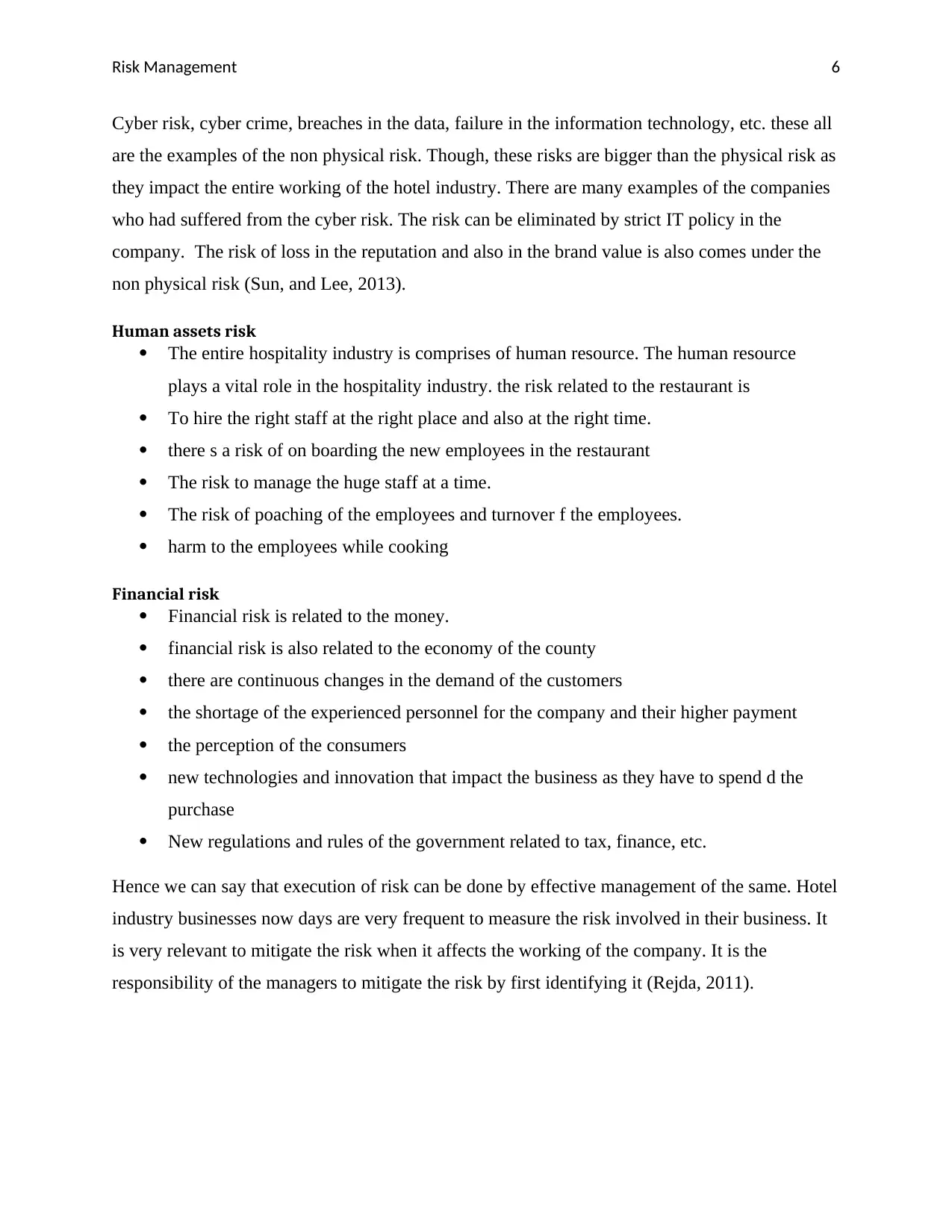
Risk Management 6
Cyber risk, cyber crime, breaches in the data, failure in the information technology, etc. these all
are the examples of the non physical risk. Though, these risks are bigger than the physical risk as
they impact the entire working of the hotel industry. There are many examples of the companies
who had suffered from the cyber risk. The risk can be eliminated by strict IT policy in the
company. The risk of loss in the reputation and also in the brand value is also comes under the
non physical risk (Sun, and Lee, 2013).
Human assets risk
The entire hospitality industry is comprises of human resource. The human resource
plays a vital role in the hospitality industry. the risk related to the restaurant is
To hire the right staff at the right place and also at the right time.
there s a risk of on boarding the new employees in the restaurant
The risk to manage the huge staff at a time.
The risk of poaching of the employees and turnover f the employees.
harm to the employees while cooking
Financial risk
Financial risk is related to the money.
financial risk is also related to the economy of the county
there are continuous changes in the demand of the customers
the shortage of the experienced personnel for the company and their higher payment
the perception of the consumers
new technologies and innovation that impact the business as they have to spend d the
purchase
New regulations and rules of the government related to tax, finance, etc.
Hence we can say that execution of risk can be done by effective management of the same. Hotel
industry businesses now days are very frequent to measure the risk involved in their business. It
is very relevant to mitigate the risk when it affects the working of the company. It is the
responsibility of the managers to mitigate the risk by first identifying it (Rejda, 2011).
Cyber risk, cyber crime, breaches in the data, failure in the information technology, etc. these all
are the examples of the non physical risk. Though, these risks are bigger than the physical risk as
they impact the entire working of the hotel industry. There are many examples of the companies
who had suffered from the cyber risk. The risk can be eliminated by strict IT policy in the
company. The risk of loss in the reputation and also in the brand value is also comes under the
non physical risk (Sun, and Lee, 2013).
Human assets risk
The entire hospitality industry is comprises of human resource. The human resource
plays a vital role in the hospitality industry. the risk related to the restaurant is
To hire the right staff at the right place and also at the right time.
there s a risk of on boarding the new employees in the restaurant
The risk to manage the huge staff at a time.
The risk of poaching of the employees and turnover f the employees.
harm to the employees while cooking
Financial risk
Financial risk is related to the money.
financial risk is also related to the economy of the county
there are continuous changes in the demand of the customers
the shortage of the experienced personnel for the company and their higher payment
the perception of the consumers
new technologies and innovation that impact the business as they have to spend d the
purchase
New regulations and rules of the government related to tax, finance, etc.
Hence we can say that execution of risk can be done by effective management of the same. Hotel
industry businesses now days are very frequent to measure the risk involved in their business. It
is very relevant to mitigate the risk when it affects the working of the company. It is the
responsibility of the managers to mitigate the risk by first identifying it (Rejda, 2011).
You're viewing a preview
Unlock full access by subscribing today!
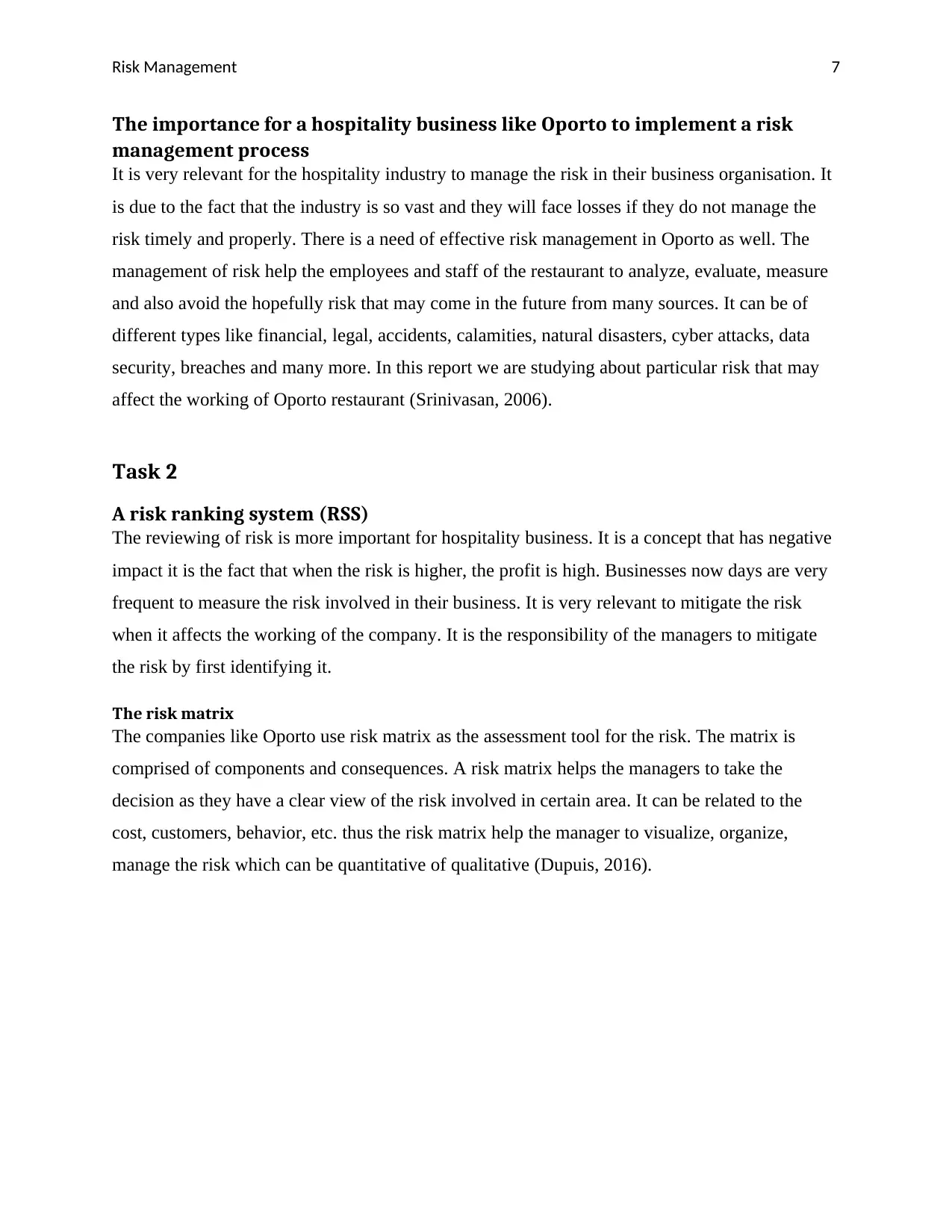
Risk Management 7
The importance for a hospitality business like Oporto to implement a risk
management process
It is very relevant for the hospitality industry to manage the risk in their business organisation. It
is due to the fact that the industry is so vast and they will face losses if they do not manage the
risk timely and properly. There is a need of effective risk management in Oporto as well. The
management of risk help the employees and staff of the restaurant to analyze, evaluate, measure
and also avoid the hopefully risk that may come in the future from many sources. It can be of
different types like financial, legal, accidents, calamities, natural disasters, cyber attacks, data
security, breaches and many more. In this report we are studying about particular risk that may
affect the working of Oporto restaurant (Srinivasan, 2006).
Task 2
A risk ranking system (RSS)
The reviewing of risk is more important for hospitality business. It is a concept that has negative
impact it is the fact that when the risk is higher, the profit is high. Businesses now days are very
frequent to measure the risk involved in their business. It is very relevant to mitigate the risk
when it affects the working of the company. It is the responsibility of the managers to mitigate
the risk by first identifying it.
The risk matrix
The companies like Oporto use risk matrix as the assessment tool for the risk. The matrix is
comprised of components and consequences. A risk matrix helps the managers to take the
decision as they have a clear view of the risk involved in certain area. It can be related to the
cost, customers, behavior, etc. thus the risk matrix help the manager to visualize, organize,
manage the risk which can be quantitative of qualitative (Dupuis, 2016).
The importance for a hospitality business like Oporto to implement a risk
management process
It is very relevant for the hospitality industry to manage the risk in their business organisation. It
is due to the fact that the industry is so vast and they will face losses if they do not manage the
risk timely and properly. There is a need of effective risk management in Oporto as well. The
management of risk help the employees and staff of the restaurant to analyze, evaluate, measure
and also avoid the hopefully risk that may come in the future from many sources. It can be of
different types like financial, legal, accidents, calamities, natural disasters, cyber attacks, data
security, breaches and many more. In this report we are studying about particular risk that may
affect the working of Oporto restaurant (Srinivasan, 2006).
Task 2
A risk ranking system (RSS)
The reviewing of risk is more important for hospitality business. It is a concept that has negative
impact it is the fact that when the risk is higher, the profit is high. Businesses now days are very
frequent to measure the risk involved in their business. It is very relevant to mitigate the risk
when it affects the working of the company. It is the responsibility of the managers to mitigate
the risk by first identifying it.
The risk matrix
The companies like Oporto use risk matrix as the assessment tool for the risk. The matrix is
comprised of components and consequences. A risk matrix helps the managers to take the
decision as they have a clear view of the risk involved in certain area. It can be related to the
cost, customers, behavior, etc. thus the risk matrix help the manager to visualize, organize,
manage the risk which can be quantitative of qualitative (Dupuis, 2016).
Paraphrase This Document
Need a fresh take? Get an instant paraphrase of this document with our AI Paraphraser
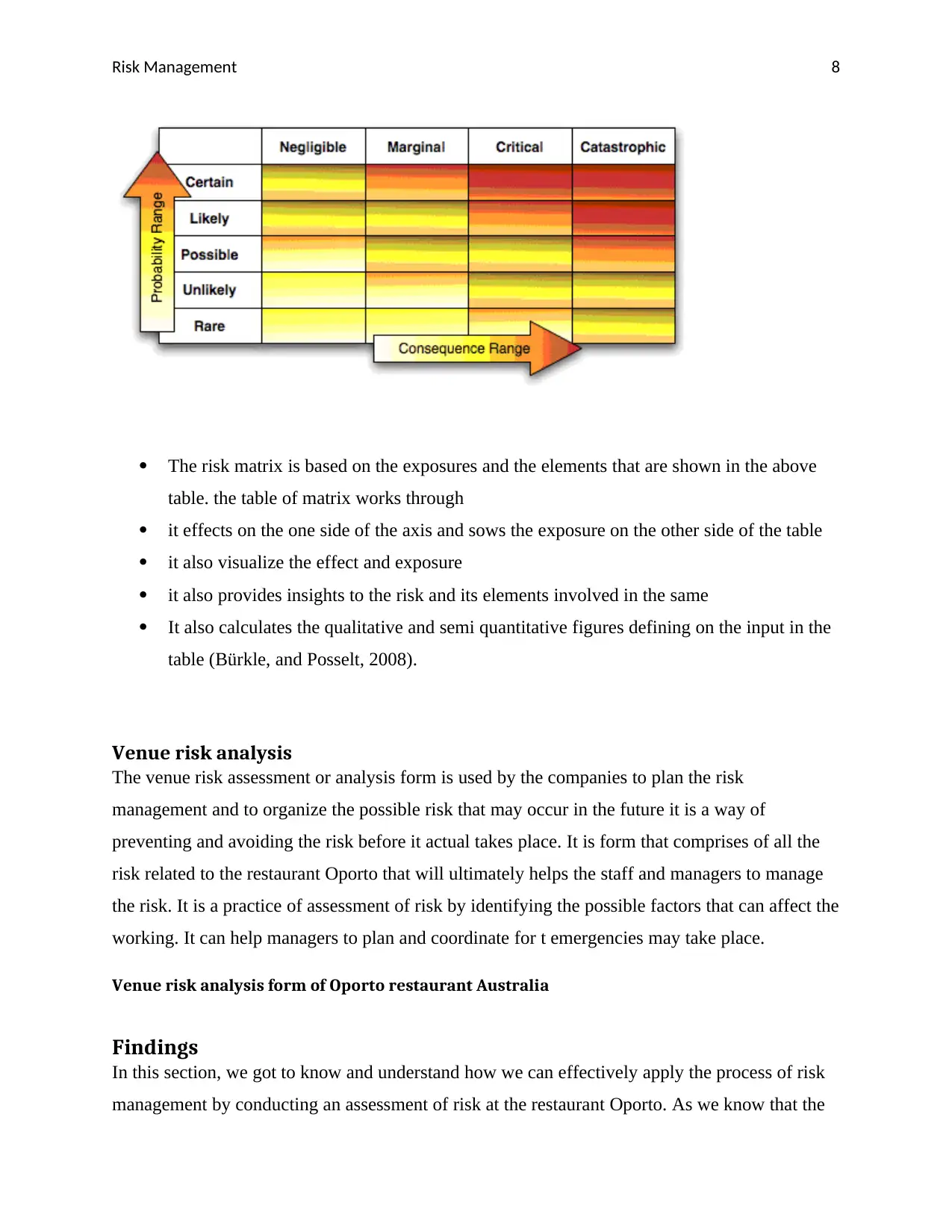
Risk Management 8
The risk matrix is based on the exposures and the elements that are shown in the above
table. the table of matrix works through
it effects on the one side of the axis and sows the exposure on the other side of the table
it also visualize the effect and exposure
it also provides insights to the risk and its elements involved in the same
It also calculates the qualitative and semi quantitative figures defining on the input in the
table (Bürkle, and Posselt, 2008).
Venue risk analysis
The venue risk assessment or analysis form is used by the companies to plan the risk
management and to organize the possible risk that may occur in the future it is a way of
preventing and avoiding the risk before it actual takes place. It is form that comprises of all the
risk related to the restaurant Oporto that will ultimately helps the staff and managers to manage
the risk. It is a practice of assessment of risk by identifying the possible factors that can affect the
working. It can help managers to plan and coordinate for t emergencies may take place.
Venue risk analysis form of Oporto restaurant Australia
Findings
In this section, we got to know and understand how we can effectively apply the process of risk
management by conducting an assessment of risk at the restaurant Oporto. As we know that the
The risk matrix is based on the exposures and the elements that are shown in the above
table. the table of matrix works through
it effects on the one side of the axis and sows the exposure on the other side of the table
it also visualize the effect and exposure
it also provides insights to the risk and its elements involved in the same
It also calculates the qualitative and semi quantitative figures defining on the input in the
table (Bürkle, and Posselt, 2008).
Venue risk analysis
The venue risk assessment or analysis form is used by the companies to plan the risk
management and to organize the possible risk that may occur in the future it is a way of
preventing and avoiding the risk before it actual takes place. It is form that comprises of all the
risk related to the restaurant Oporto that will ultimately helps the staff and managers to manage
the risk. It is a practice of assessment of risk by identifying the possible factors that can affect the
working. It can help managers to plan and coordinate for t emergencies may take place.
Venue risk analysis form of Oporto restaurant Australia
Findings
In this section, we got to know and understand how we can effectively apply the process of risk
management by conducting an assessment of risk at the restaurant Oporto. As we know that the
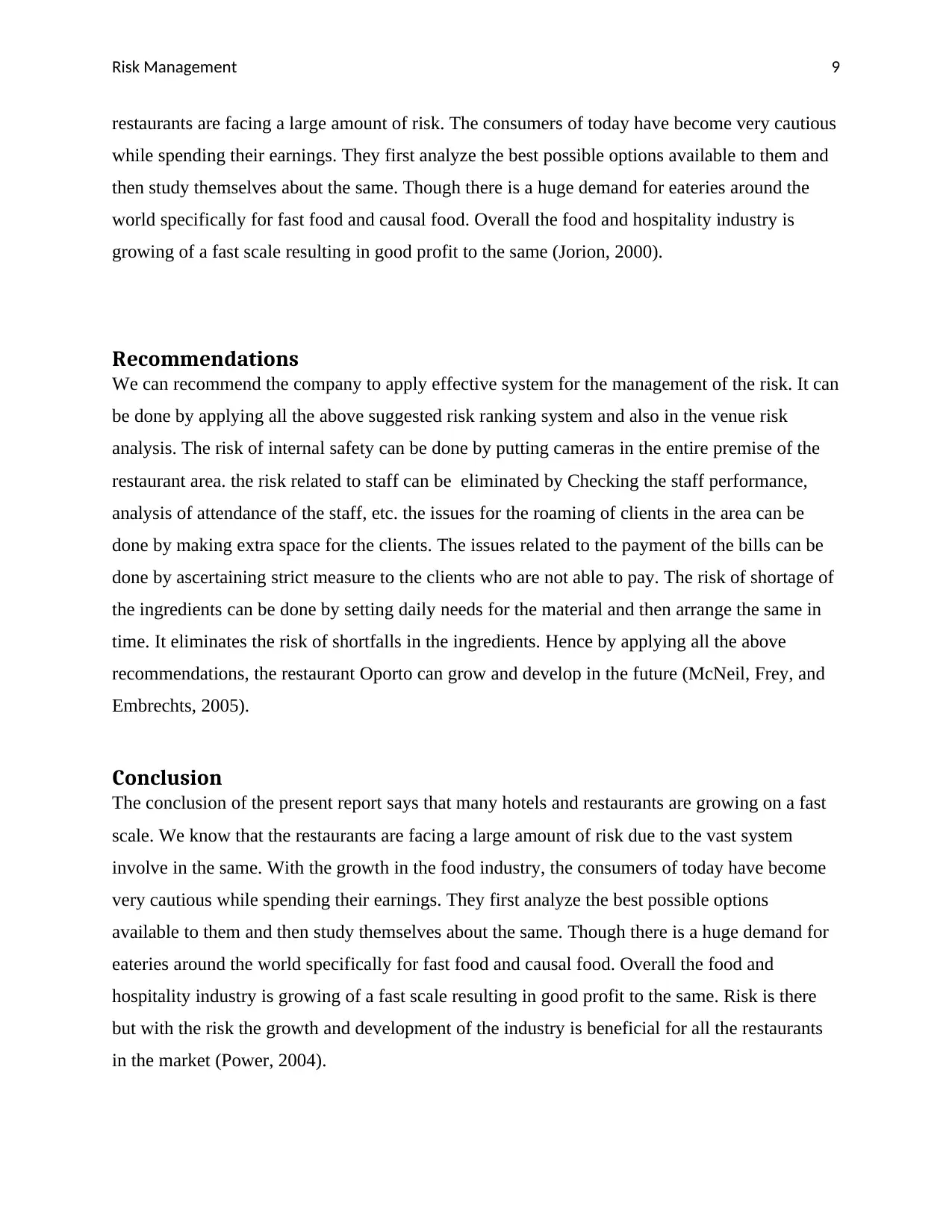
Risk Management 9
restaurants are facing a large amount of risk. The consumers of today have become very cautious
while spending their earnings. They first analyze the best possible options available to them and
then study themselves about the same. Though there is a huge demand for eateries around the
world specifically for fast food and causal food. Overall the food and hospitality industry is
growing of a fast scale resulting in good profit to the same (Jorion, 2000).
Recommendations
We can recommend the company to apply effective system for the management of the risk. It can
be done by applying all the above suggested risk ranking system and also in the venue risk
analysis. The risk of internal safety can be done by putting cameras in the entire premise of the
restaurant area. the risk related to staff can be eliminated by Checking the staff performance,
analysis of attendance of the staff, etc. the issues for the roaming of clients in the area can be
done by making extra space for the clients. The issues related to the payment of the bills can be
done by ascertaining strict measure to the clients who are not able to pay. The risk of shortage of
the ingredients can be done by setting daily needs for the material and then arrange the same in
time. It eliminates the risk of shortfalls in the ingredients. Hence by applying all the above
recommendations, the restaurant Oporto can grow and develop in the future (McNeil, Frey, and
Embrechts, 2005).
Conclusion
The conclusion of the present report says that many hotels and restaurants are growing on a fast
scale. We know that the restaurants are facing a large amount of risk due to the vast system
involve in the same. With the growth in the food industry, the consumers of today have become
very cautious while spending their earnings. They first analyze the best possible options
available to them and then study themselves about the same. Though there is a huge demand for
eateries around the world specifically for fast food and causal food. Overall the food and
hospitality industry is growing of a fast scale resulting in good profit to the same. Risk is there
but with the risk the growth and development of the industry is beneficial for all the restaurants
in the market (Power, 2004).
restaurants are facing a large amount of risk. The consumers of today have become very cautious
while spending their earnings. They first analyze the best possible options available to them and
then study themselves about the same. Though there is a huge demand for eateries around the
world specifically for fast food and causal food. Overall the food and hospitality industry is
growing of a fast scale resulting in good profit to the same (Jorion, 2000).
Recommendations
We can recommend the company to apply effective system for the management of the risk. It can
be done by applying all the above suggested risk ranking system and also in the venue risk
analysis. The risk of internal safety can be done by putting cameras in the entire premise of the
restaurant area. the risk related to staff can be eliminated by Checking the staff performance,
analysis of attendance of the staff, etc. the issues for the roaming of clients in the area can be
done by making extra space for the clients. The issues related to the payment of the bills can be
done by ascertaining strict measure to the clients who are not able to pay. The risk of shortage of
the ingredients can be done by setting daily needs for the material and then arrange the same in
time. It eliminates the risk of shortfalls in the ingredients. Hence by applying all the above
recommendations, the restaurant Oporto can grow and develop in the future (McNeil, Frey, and
Embrechts, 2005).
Conclusion
The conclusion of the present report says that many hotels and restaurants are growing on a fast
scale. We know that the restaurants are facing a large amount of risk due to the vast system
involve in the same. With the growth in the food industry, the consumers of today have become
very cautious while spending their earnings. They first analyze the best possible options
available to them and then study themselves about the same. Though there is a huge demand for
eateries around the world specifically for fast food and causal food. Overall the food and
hospitality industry is growing of a fast scale resulting in good profit to the same. Risk is there
but with the risk the growth and development of the industry is beneficial for all the restaurants
in the market (Power, 2004).
You're viewing a preview
Unlock full access by subscribing today!
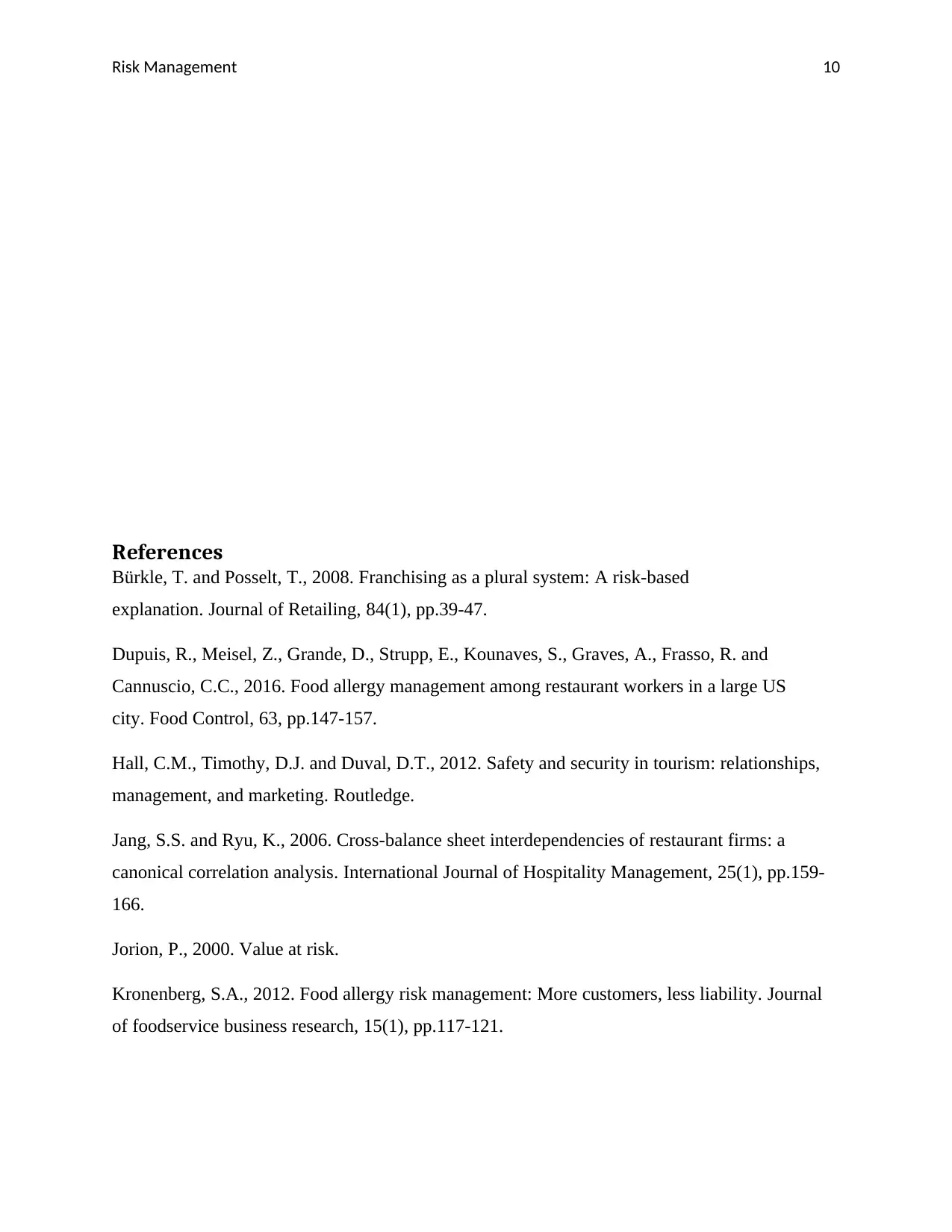
Risk Management 10
References
Bürkle, T. and Posselt, T., 2008. Franchising as a plural system: A risk-based
explanation. Journal of Retailing, 84(1), pp.39-47.
Dupuis, R., Meisel, Z., Grande, D., Strupp, E., Kounaves, S., Graves, A., Frasso, R. and
Cannuscio, C.C., 2016. Food allergy management among restaurant workers in a large US
city. Food Control, 63, pp.147-157.
Hall, C.M., Timothy, D.J. and Duval, D.T., 2012. Safety and security in tourism: relationships,
management, and marketing. Routledge.
Jang, S.S. and Ryu, K., 2006. Cross-balance sheet interdependencies of restaurant firms: a
canonical correlation analysis. International Journal of Hospitality Management, 25(1), pp.159-
166.
Jorion, P., 2000. Value at risk.
Kronenberg, S.A., 2012. Food allergy risk management: More customers, less liability. Journal
of foodservice business research, 15(1), pp.117-121.
References
Bürkle, T. and Posselt, T., 2008. Franchising as a plural system: A risk-based
explanation. Journal of Retailing, 84(1), pp.39-47.
Dupuis, R., Meisel, Z., Grande, D., Strupp, E., Kounaves, S., Graves, A., Frasso, R. and
Cannuscio, C.C., 2016. Food allergy management among restaurant workers in a large US
city. Food Control, 63, pp.147-157.
Hall, C.M., Timothy, D.J. and Duval, D.T., 2012. Safety and security in tourism: relationships,
management, and marketing. Routledge.
Jang, S.S. and Ryu, K., 2006. Cross-balance sheet interdependencies of restaurant firms: a
canonical correlation analysis. International Journal of Hospitality Management, 25(1), pp.159-
166.
Jorion, P., 2000. Value at risk.
Kronenberg, S.A., 2012. Food allergy risk management: More customers, less liability. Journal
of foodservice business research, 15(1), pp.117-121.
Paraphrase This Document
Need a fresh take? Get an instant paraphrase of this document with our AI Paraphraser
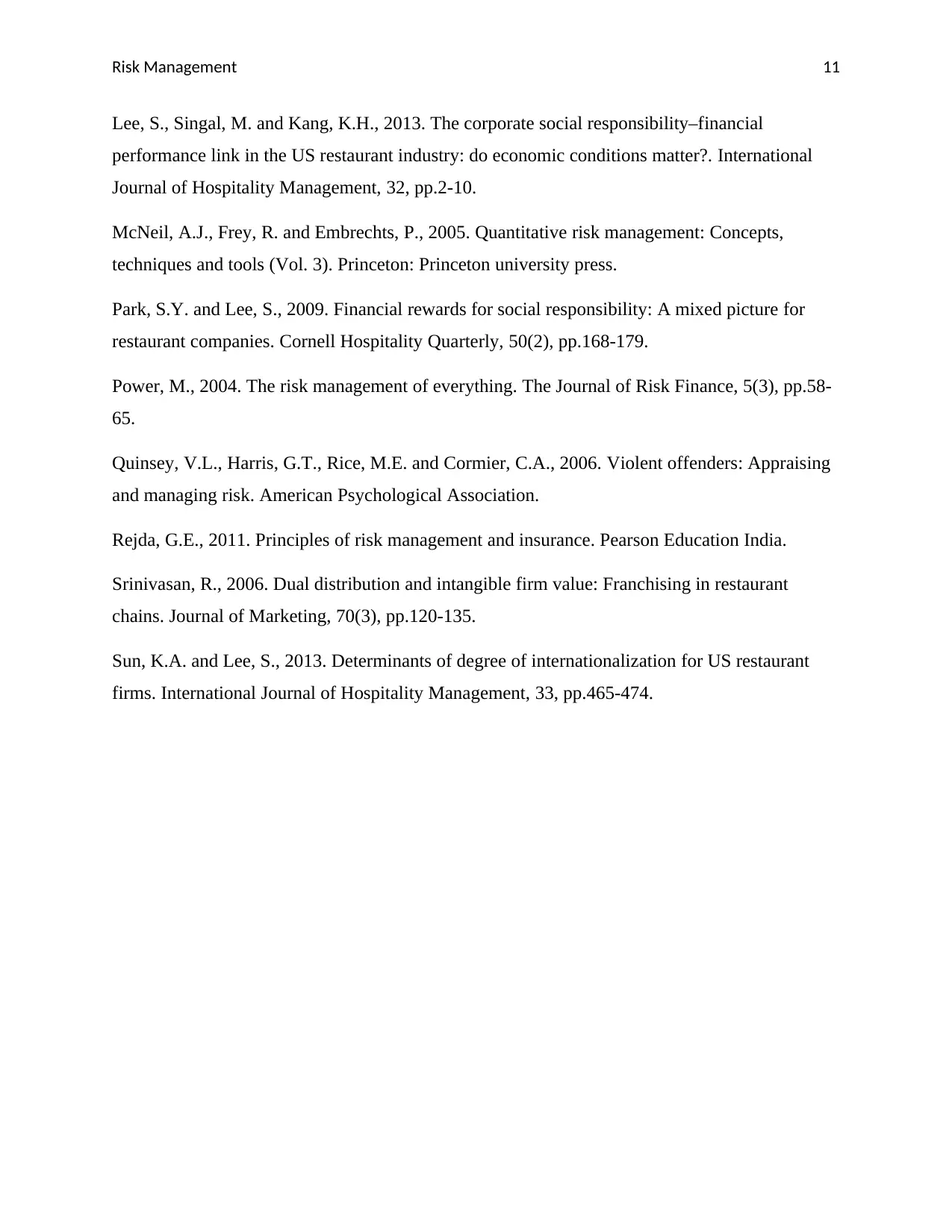
Risk Management 11
Lee, S., Singal, M. and Kang, K.H., 2013. The corporate social responsibility–financial
performance link in the US restaurant industry: do economic conditions matter?. International
Journal of Hospitality Management, 32, pp.2-10.
McNeil, A.J., Frey, R. and Embrechts, P., 2005. Quantitative risk management: Concepts,
techniques and tools (Vol. 3). Princeton: Princeton university press.
Park, S.Y. and Lee, S., 2009. Financial rewards for social responsibility: A mixed picture for
restaurant companies. Cornell Hospitality Quarterly, 50(2), pp.168-179.
Power, M., 2004. The risk management of everything. The Journal of Risk Finance, 5(3), pp.58-
65.
Quinsey, V.L., Harris, G.T., Rice, M.E. and Cormier, C.A., 2006. Violent offenders: Appraising
and managing risk. American Psychological Association.
Rejda, G.E., 2011. Principles of risk management and insurance. Pearson Education India.
Srinivasan, R., 2006. Dual distribution and intangible firm value: Franchising in restaurant
chains. Journal of Marketing, 70(3), pp.120-135.
Sun, K.A. and Lee, S., 2013. Determinants of degree of internationalization for US restaurant
firms. International Journal of Hospitality Management, 33, pp.465-474.
Lee, S., Singal, M. and Kang, K.H., 2013. The corporate social responsibility–financial
performance link in the US restaurant industry: do economic conditions matter?. International
Journal of Hospitality Management, 32, pp.2-10.
McNeil, A.J., Frey, R. and Embrechts, P., 2005. Quantitative risk management: Concepts,
techniques and tools (Vol. 3). Princeton: Princeton university press.
Park, S.Y. and Lee, S., 2009. Financial rewards for social responsibility: A mixed picture for
restaurant companies. Cornell Hospitality Quarterly, 50(2), pp.168-179.
Power, M., 2004. The risk management of everything. The Journal of Risk Finance, 5(3), pp.58-
65.
Quinsey, V.L., Harris, G.T., Rice, M.E. and Cormier, C.A., 2006. Violent offenders: Appraising
and managing risk. American Psychological Association.
Rejda, G.E., 2011. Principles of risk management and insurance. Pearson Education India.
Srinivasan, R., 2006. Dual distribution and intangible firm value: Franchising in restaurant
chains. Journal of Marketing, 70(3), pp.120-135.
Sun, K.A. and Lee, S., 2013. Determinants of degree of internationalization for US restaurant
firms. International Journal of Hospitality Management, 33, pp.465-474.
1 out of 11
Related Documents
Your All-in-One AI-Powered Toolkit for Academic Success.
+13062052269
info@desklib.com
Available 24*7 on WhatsApp / Email
![[object Object]](/_next/static/media/star-bottom.7253800d.svg)
Unlock your academic potential
© 2024 | Zucol Services PVT LTD | All rights reserved.





